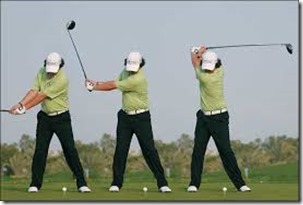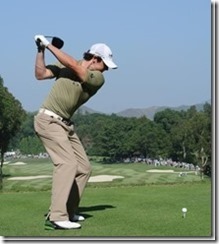The Turn–The most important golf swing thought
If your backswing follows an incorrect path, your club will not end up in the correct SLOT on the top of your swing. Which means, it will not follow the correct path on your downswing. So – how exactly – do you ensure that your backswing stays on track? You simply TURN away from the ball. (In a previous post, I describe in some detail what a golf turn (away from the ball) should feel like. In brief, it should be GENTLE, it should adhere to a couple of simple checkpoints, and it should not be overdone (no overswinging)).
The TEMPO of a turn
You see, your body and mind already KNOW how to turn back from something. The tempo for doing so is already ingrained. Unlike the TEMPO for picking up a golf club and moving it UP and AROUND the body. Also, you do not need to THINK consciously about where your SHOULDERS or hands or arms are! Too often, golf coaches get lost in these details – and start minutely examining the position of your hands and shoulders and every part of your body. To CONSCIOUSLY try and REPRODUCE those positions is beyond most amateurs – and, I think, counterproductive to learning the backswing. This is why the TURNING ACTION is key to getting the backswing right. The ACTION itself is nothing that you have to learn – you simply have to execute it (you already KNOW this action). The ONLY thing you need to remember is to TURN back on the correct plane – and this is where the CHECKPOINT below helps.
How to start your TURN (away from the ball)
Your chin should start turning away along with your shoulders. The same as what would happen if you normally turned away from someone.
The CHECKPOINT (hands at shoulder height)
Some coaches want you to keep track of where the club is at all points during the backswing. They have too many checkpoints. As I discussed in this post, if you get the FIRST COUPLE of FEET right (on the backswing), the rest will automatically take care of itself. However, some people function better with a few checkpoints. There are TWO CHECKPOINTS that I would recommend – and that you can OBSERVE in any pro golfer’s backswing.
The FIRST checkpoint (Thumbs pointed to the sky at shoulder height, club pointed towards the sky. See Rory in the LEFT picture – the hands at shoulder height – club pointing towards sky). This is an easy to visualize checkpoint – and one that Jack Nicklaus’s coach (Jack Grout) used to emphasize. Almost every golfer has the same position (when the hands are at shoulder height).
The SECOND checkpoint (see RIGHT picture) – Clubshaft parallel to the ground – on the completion of the backswing . This is one that you will see in ALL professionals on tour (a few exceptions , like John Daly, may overswing beyond the parallel, but these are rare exceptions).
| Checkpoint 1 (shoulder height, middle picture) | Checkpoint 2 (end of backswing) |
 |
 |
Combine the TURN with the CHECKPOINT
If you were to simply execute the TURN, you may not have the club on the correct plane (may not hit the checkpoints). To ensure that the club is traveling back correctly, you need to have a checkpoint or two. I prefer to deal with just one checkpoint – the one when the hands reach shoulder height. Simply ensure that the club is pointed straight towards the sky (as Rory illustrates in the left image above).
If you were to simply REPLICATE the checkpoint, without TURNING away from the ball, your tempo would (MIGHT) be off. In other words, you COULD, conceivably, get your club pointing towards the sky, without actually TURNING your body (using your hands and arms only). A lot of amateurs do just this – and fail to actually TURN AWAY from the ball. The TURN serves a double purpose – a) It ensures your BODY gets in on the backswing – and not just your hands and arms. b) It provides you with the correct TEMPO – the correct time spent on the backswing. In a sport like tennis, you do not have to think about the TIME spent on taking the racquet back –you just do it automatically. However, in golf, since there is a WEIGHT attached to the end of the RACQUET (so to speak), the timing becomes important. The WEIGHT will not let you just whip the racquet back – as you would whip a tennis racquet back. Fortunately, the ACT of EXECUTING a TURN away from the ball, takes care of this detail. It provides the body with the correct timing for taking the club back.
SETTING up to TURN
What exactly do I mean when I say ‘Setup so that you are PRIMED to turn away from the ball?’ As you approach the ball (from the side), execute a NATURAL turn away from it (just as you would turn away from a person). Your LEFT SHOULDER should be turned (slightly) towards the target now. Think of it as a half-hearted turn away from someone. You started to turn away – then stopped. That is what it should feel like. The beauty of this ‘half-turn’ is that the body is now ready to execute the FULL turn. The FULL turn would just be a SMOOTH continuation of this Half-turn. You ABSOLUTELY need to COMBINE this half-turn (of the upper body) with the RIGHT HIP BEND. These are the ONLY TWO SETUP tips you need to execute a powerful (and SMOOTH) turn away from the ball.
SUMMARY
So, to summarize, the TURN by itself is not enough (can get you TURNING OFF PLANE) – and the PLANE (CHECKPOINT) , by itself, is not enough (may not involve the UPPER body muscles, and may be off-tempo).
Note that nowhere did I mention anything about SHOULDERS, ARMS , hands etc. This is because, your body already KNOWS how to turn away from the ball. TURNING is an action you can do with your eyes closed – and your hands, arms and shoulders will execute it perfectly.
Just COMBINE the TURN with the CHECKPOINT, for the correct, professional backswing.
I promise you – not only will your completed backswing look like Rory’s above (with the SHAFT completely parallel to the ground), but it will FEEL like Rory’s backswing. This is because you will have incorporated the upper body muscles in your backswing.
Thank you.
Greatly appreciate it. I really think your post is so helpful, really helps me understand the swing/”real” turn. I’ve been all arms..not good. I’ll work on this. Looking forward to reading your previous post on turn and other golf help.
All the best.
Arti❤️🏌